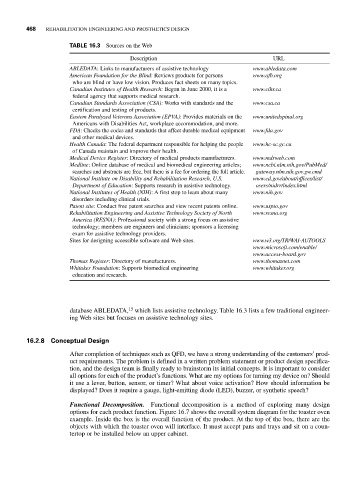Page 490 - Biomedical Engineering and Design Handbook Volume 2, Applications
P. 490
468 REHABILITATION ENGINEERING AND PROSTHETICS DESIGN
TABLE 16.3 Sources on the Web
Description URL
ABLEDATA: Links to manufacturers of assistive technology www.abledata.com
American Foundation for the Blind: Reviews products for persons www.afb.org
who are blind or have low vision. Produces fact sheets on many topics.
Canadian Institutes of Health Research: Begun in June 2000, it is a www.cihr.ca
federal agency that supports medical research.
Canadian Standards Association (CSA): Works with standards and the www.csa.ca
certification and testing of products.
Eastem Paralyzed Veterans Association (EPVA): Provides materials on the www.unitedspinal.org
Americans with Disabilities Act, workplace accommodation, and more.
FDA: Checks the codes and standards that affect durable medical equipment www.fda.gov
and other medical devices.
Health Canada: The federal department responsible for helping the people www.hc-sc.gc.ca
of Canada maintain and improve their health.
Medical Device Register: Directory of medical products manufacturers. www.mdrweb.com
Medline: Online database of medical and biomedical engineering articles; www.ncbi.nlm.nih.gov/PubMed/
searches and abstracts are free, but there is a fee for ordering the full article. gateway.nlm.nih.gov.gw.cmd
National Institute on Disability and Rehabilitation Research, U.S. www.ed.gov/about/offices/list/
Department of Education: Supports research in assistive technology. osers/nidrr/index.html
National Institutes of Health (NIH): A first stop to leam about many www.nih.gov
disorders including clinical trials.
Patent site: Conduct free patent searches and view recent patents online. www.uspto.gov
Rehabilitation Engineering and Assistive Technology Society of North www.resna.org
America (RESNA): Professional society with a strong focus on assistive
technology; members are engineers and clinicians; sponsors a licensing
exam for assistive technology providers.
Sites for designing accessible software and Web sites. www.w3.org/TR/WAI-AUTOOLS
www.microsoft.com/enable/
www.access-board.gov
Thomas Register: Directory of manufacturers. www.thomasnet.com
Whitaker Foundation: Supports biomedical engineering www.whitaker.org
education and research.
15
database ABLEDATA, which lists assistive technology. Table 16.3 lists a few traditional engineer-
ing Web sites but focuses on assistive technology sites.
16.2.8 Conceptual Design
After completion of techniques such as QFD, we have a strong understanding of the customers’ prod-
uct requirements. The problem is defined in a written problem statement or product design specifica-
tion, and the design team is finally ready to brainstorm its initial concepts. It is important to consider
all options for each of the product’s functions. What are my options for turning my device on? Should
it use a lever, button, sensor, or timer? What about voice activation? How should information be
displayed? Does it require a gauge, light-emitting diode (LED), buzzer, or synthetic speech?
Functional Decomposition. Functional decomposition is a method of exploring many design
options for each product function. Figure 16.7 shows the overall system diagram for the toaster oven
example. Inside the box is the overall function of the product. At the top of the box, there are the
objects with which the toaster oven will interface. It must accept pans and trays and sit on a coun-
tertop or be installed below an upper cabinet.

